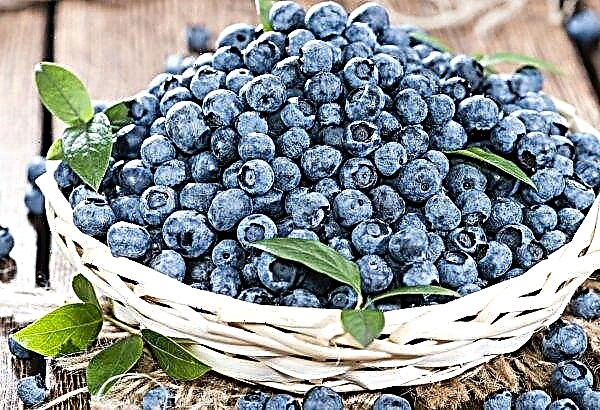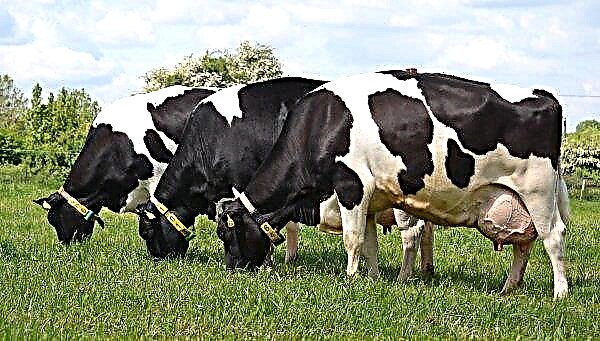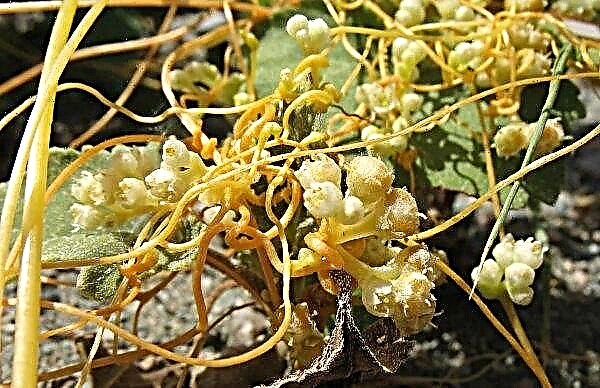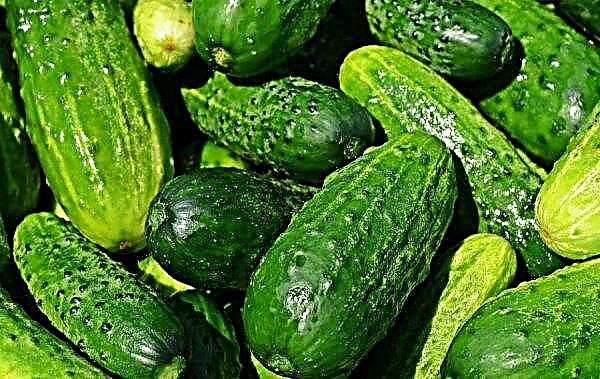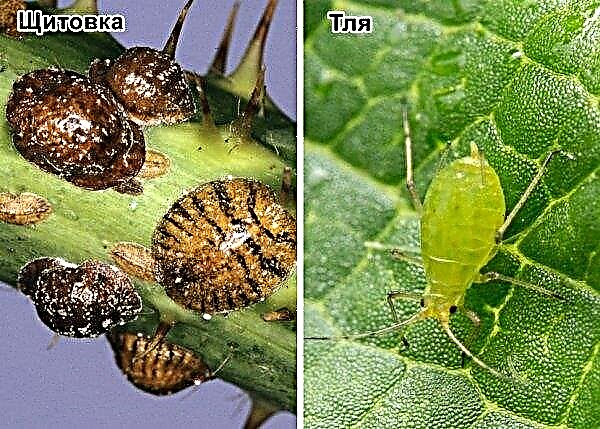Watermelon is a favorite treat for everyone, which most people associate with summer, the sun and boundless sweetness. One of the varieties of culture popular around the world is Kholodok - a representative of melons, which can be grown in greenhouses or in the open.
Did you know? The Guinness Book of Records recorded that in 2013 in the United States, farmer K. Kent raised a watermelon weighing almost 160 kg.
Description and characteristics of the variety
The homeland of watermelons of the Kholodok variety is the Vologda Oblast of Russia, where breeder K.M.Sancha worked on crossbreeding several varieties and as a result received this medium-late variety, which has the following characteristics:
- strong bush with a sufficient number of lateral shoots, the main stem can reach a length of 5 m;
- large leaves of green color, of medium degree of dissection, have a slight edge;
- ripe fruits of spherical shape, slightly elongated, average weight 5.5–7 kg;
- smooth peel with barely noticeable green veins;
- fruit type - dessert, usually have a very sweet taste and bright red pulp;
- the seeds reach 16–20 mm in length; the approximate weight of 100 seeds is 12–13 g;
- ripening time - 86–96 days from the appearance of seedlings to the start of harvesting;
- productivity - 30–34 tons / ha;
- Suitable for both greenhouse and outdoor cultivation.

Pros and cons of the variety
- Advantages inherent in the grade Chill:
- excellent taste;
- good presentation;
- fairly high yields;
- well tolerates storage and transportation;
- resistant to cold snap.
- It is worth saying a few words about the typical disadvantages of the variety:
- long shoots need a large area for growth;
- to get a good crop of large fruits, you need to quite often remove the lateral processes;
- good productivity requires a lot of sunlight and a comfortable temperature of the soil and air.
Optimal timing for growing
The most favorable time for planting the Chill is the end of spring (May) - the beginning of summer. That is, the work must be carried out during that period of the warm season, when the soil is already warm enough and there is no risk of accidental frosts that could adversely affect the crop. If, after landing in the ground, the night temperature began to drop, the melon must be covered with a film, otherwise you should not wait for a normal crop.
Important! The most favorable conditions for growing watermelons are hot, dry summers with a lot of sunlight, additional watering should only be done with fertilizers. Otherwise, even if you get a plentiful crop of outwardly beautiful large fruits, most likely, they will be unsweetened.
Preparatory work
Before planting seeds or seedlings in the ground, it is necessary to carry out some preparatory measures.
Site selection and preparation
The plot for melon should be in an open area, which is adequately lit by the sun. The most suitable substrate is light soil with good aeration. The most acceptable type of soil is sandy or sandy loam, because it is such soil that prevails in the south of the African continent - the birthplace of culture. If you have no sign of such a site, do not worry, you can choose a site with good lighting and prepare it.
To do this, the earth should be well weeded several times and fertilized for gourds. As already mentioned, among the few disadvantages characteristic of this variety, there is this: the need for a sufficiently large area, since the bush grows very much. When choosing a site, this factor should be considered. The optimal planting pattern is a rectangle with sides of 0.7 × 1.4 m, in the corners of which seeds or seedlings will be planted. If the soil is acidified (pH less than 6.0), make wood ash (1 kg / m²), but manure is not necessary in the spring, this will attract the bear. But this organic matter can be introduced into the soil during autumn work. For spring preparation of the site, mineral dressings, which include nitrogen, are suitable. Such fertilizers are applied 15–20 days before planting seedlings or seeds.
If the soil is acidified (pH less than 6.0), make wood ash (1 kg / m²), but manure is not necessary in the spring, this will attract the bear. But this organic matter can be introduced into the soil during autumn work. For spring preparation of the site, mineral dressings, which include nitrogen, are suitable. Such fertilizers are applied 15–20 days before planting seedlings or seeds.
Do not forget about the sevosmena. Watermelons should not be planted after cucumbers and strawberries, but after cabbage, tomatoes, black radish and herbs, they grow well. In addition, it is better not to break the melon next to the pumpkin, zucchini, squash and cucumbers. But greens and corn will be wonderful neighbors for watermelons.
Did you know? Potassium, the lycopene pigment and divalent nitric oxide contained in watermelons are very useful for keeping the kidneys healthy. In addition, the specific diuretic properties of the culture contribute to the dissolution and elimination of stones.
Seed preparation
The selection and preparation of seed material (both for seedlings and seedlings) is the most critical step in the cultivation of melons, if you want to get a good harvest, so it’s better to pay for the seeds more expensive by purchasing them from a trusted supplier or using your own harvesting material. First, you should check the seeds: put them in a container with water at room temperature and leave for 10-15 minutes. After the specified time, the remaining on the surface can be discarded - they are empty and will not give a crop. The remaining seeds are treated with a 1% solution of potassium permanganate (leave the seeds in the solution for 1 hour) or with growth stimulants for gourds according to the instructions ("Emistim C", "Biolan"). After the stimulation procedure, the seeds are dried and then planted in containers for seedlings or immediately into the ground.
After the specified time, the remaining on the surface can be discarded - they are empty and will not give a crop. The remaining seeds are treated with a 1% solution of potassium permanganate (leave the seeds in the solution for 1 hour) or with growth stimulants for gourds according to the instructions ("Emistim C", "Biolan"). After the stimulation procedure, the seeds are dried and then planted in containers for seedlings or immediately into the ground.
Cultivation methods
There are three main methods for growing watermelons:
- pre-growing seedlings (at home or in a greenhouse) followed by transplanting into the ground;
- growing from seeds in open ground directly at the site of further breeding;
- growing in a greenhouse with subsequent harvesting of fruits there (full cycle).
Seedling method
This method of growing melons is somewhat more time-consuming than growing with seeds directly planted in the ground.
- However, this method has several advantages:
- you will get a much earlier crop;
- only the strongest and most healthy seedlings can be planted in the ground.
Landing time
When growing by seedling, the seeds are prepared for planting in April, planting them on seedlings, which, after the appearance of healthy seedlings, are transferred to the greenhouse. Seedlings are considered to have reached the necessary conditions after the formation of 3-4 real leaves on seedlings. Usually, 4–5 weeks after planting seeds in seedlings is sufficient for this.
Landing technology
To grow seedlings, prepare the soil. You can purchase a ready-made mixture for melon seedlings at specialized retail outlets, or you can prepare the substrate yourself in this way:
- humus - 8 l;
- sod - 2 l;
- ash - 2 tbsp. l .;
- ammonium nitrate - 1 g;
- superphosphate - 3 g.
Did you know? In ancient Egypt, watermelons were grown 2000 BC. Seeds of culture were discovered during excavations in Sudan and Libya, their age, respectively, 3,500 and 7,000 years.
First you need to mix the turf with humus and calcine the mixture in the oven for 15 minutes (+ 200 ° C) or spill with a 1% solution of potassium permanganate in boiling water. After that, the remaining fertilizer ingredients should be added to the dried mixture and mix well.
Seedlings can be grown in common containers with subsequent thinning (after emergence). In this case, after the seedlings are extended, they should be carefully examined. Those that look the most powerful and healthy are left for subsequent transplantation into separate containers, the rest are removed.
Seedling Care
To obtain strong healthy seedlings in the greenhouse, it is necessary to maintain the temperature regime - +26 ... + 30 ° С during the day, +17 ... + 19 ° С at night and humidity at 65–70%. The first time containers with seedlings are kept under the film, from time to time opening it.
Planting seedlings in the ground
After 3-4 leaves appear on the seedlings (this approximately corresponds to the end of May), they can be planted in the soil in the prepared soil.
Important! Ash is an excellent top dressing for all pumpkin, and for watermelons in particular. However, there is not enough nitrogen in it, which is necessary for the formation of the plant, the development of greenery. Deficiency of this element is fraught with poor development of the plant, as a result of which it will grow weak.
Seed directly into the ground
As mentioned above, the landing pattern is a rectangle having sides of 0.7 × 1.4 m. Break the prepared area into such figures (by eye, or by pegs and rope), dig holes 9–2 deep in the corners 12 cm
Care Features
Caring for plants is another important component for obtaining a crop that will delight you to the fullest. It cannot be said that the culture of this variety is distinguished by some special capricious disposition, but certain procedures, which will be discussed below, must be carried out on time.
Watering and feeding
Watering is recommended only during the period of plant development, and then only if the weather is arid. After the appearance of the ovaries and the formation of fruits, excessive watering is not only not needed, it can harm. There is a simple rule on how to determine if watering is needed: if the topsoil is dry and cracked, you can water it. Recommended water temperature is +21 ... + 24 ° С. As an organic top dressing for watermelons Chill, wood ash and bird droppings are well established.
Important! Do not mix wood ash with manure, as nitrogen efficiency decreases. Ash should be used only after manure (if you use both fertilizers). The order is as follows: with growth - nitrogen (manure), with the formation of fruits and fruiting - potassium and phosphorus (ash).
The culture needs potassium and phosphorus, which are sufficiently contained in the ash. Among the advantages of using ash, it is worth mentioning the prolonged action of this top dressing: being in the ground, it gradually gives off useful substances. There is enough nitrogen in cattle manure. But you should be extremely careful with this substance: excess manure attracts the bear. In addition, nitrogen is rich in potassium, which is also an extremely important macronutrient for the growth and development of crops, but phosphorus in manure is not enough.
That is, organic fertilizing should be complex, combining all the necessary micro and macro elements; during the season, it is necessary to feed the culture 6–8 times. After all, the plant needs somewhere to take the substances necessary for the formation of a sufficient number of fruits weighing 5-6 or more kilograms. A good option is top dressing such as compost (a mixture of cattle manure, litter, fertile soil, food debris and weeds). They begin to prepare such a mixture even before the start of autumn-winter gardening, gradually collecting it in special compost pits, where it will be fermented (fermented). You can distinguish ready-made compost from unripe one by a characteristic smell: when a strong, stable odor of hydrogen sulfide appears, know that the compost is ready and can be used. A very good solution would be to introduce such a mixture during digging when preparing a site for melon.
They begin to prepare such a mixture even before the start of autumn-winter gardening, gradually collecting it in special compost pits, where it will be fermented (fermented). You can distinguish ready-made compost from unripe one by a characteristic smell: when a strong, stable odor of hydrogen sulfide appears, know that the compost is ready and can be used. A very good solution would be to introduce such a mixture during digging when preparing a site for melon.
Important! Try knocking on a watermelon - the sound of the ripened fetus will be deaf, when squeezed, you can hear a slight crack, while the ripe fetus has a characteristic luster, and the waxy coating disappears.
Another fairly good feeding method is a manure solution, which is prepared in this way:
- Fill the bucket with 1/3 manure; fill to the top with water.
- Within 7-9 days, the contents reach their conditions with daily stirring.
- After the specified time, 1 liter of the product is diluted in 1 bucket of water.
- The bushes are watered with the resulting solution before flowering (during flowering and subsequent budding, there is an urgent need for nitrogen, the need for potassium and phosphorus comes first).
Video: dressing for watermelon
After the plant bloomed and the ovaries began to form, you need to switch to ash. Prepare an irrigation solution as follows:
- 1 kg of ash is stirred in 1 bucket of water.
- Insist the solution for 7-8 days, periodically mixing.
- The resulting solution is watered basal area of the bush.
The formation of the bush and pinch
After the bushes harden in the ground and stretch enough, they should be tied up. This procedure will enable the plant to develop better, free up additional area on the melon, and the fact that the stem will not lie on the ground will reduce the risk of developing diseases and the appearance of parasites. In addition, another advantage of this agrotechnical technique is an increase in illumination and, accordingly, heat production by each leaf. They carry out the garter in this way: install between the rows of trellis 1.2–1.5 m high. Tie each plant to the trellis at a height of 0.5–0.6 m. In order for the watermelons to grow large, pinch new shoots (lashes). The fact is that they will also form fruits, but in the end you will get a large number of small watermelons.
They carry out the garter in this way: install between the rows of trellis 1.2–1.5 m high. Tie each plant to the trellis at a height of 0.5–0.6 m. In order for the watermelons to grow large, pinch new shoots (lashes). The fact is that they will also form fruits, but in the end you will get a large number of small watermelons.
In addition, the plant will spend its strength not on the development and ripening of already formed fruits, but on the growth of green mass and the formation of new ovaries. Unnecessary lashes are pinched after the garter procedure. When new ones appear, they are also removed over 1-3 leaves. Pinching the plant should also be done if the shoots are not tied up, but lie on the ground, this contributes to better illumination of the fruits by the rays of the sun.
Important! Trellis for watermelon must be very durable. Assume that the total weight of the fruits of one plant can reach 25–30 kg and more.
In addition to pinching the lashes, extra ovaries should be removed. Make sure that one bush has no more than three ovaries, then you can count on a crop of large watermelons. In the event that you decide to grow watermelons using trellis, you should also take care of the garter of the fruit, otherwise, under their own weight, they will cut off the stem of the plant. The fruits are placed in a special net, which, in turn, is tied to the trellis.
Pests and diseases
Diseases such as anthracnose or powdery mildew are quite normal for the chill, and the variety has innate immunity. Consider the most common diseases.
Fusarium A fungal disease that can affect both seedlings and an adult plant. The root system suffers first, so the disease is difficult to identify in the initial stage. A rust-colored coating appears on the roots, which then darkens, and the stems and foliage begin to rot, dry and crumble. Plant development stops. Since an acidic environment is preferable for any fungus, dolomite flour is added as a preventive measure during the digging of future melon (300-350 g / m²). During preplant seed preparation, they are treated according to the instructions with Fitosporin or Gliocladin preparations. In the period of seedling growth, it is watered or sprayed with Previkur every 1.5–2 weeks.
Since an acidic environment is preferable for any fungus, dolomite flour is added as a preventive measure during the digging of future melon (300-350 g / m²). During preplant seed preparation, they are treated according to the instructions with Fitosporin or Gliocladin preparations. In the period of seedling growth, it is watered or sprayed with Previkur every 1.5–2 weeks.
In early summer, plants are watered with a 1% solution of potassium permanganate and 0.1% solution of boric acid. In the event that the melons still get sick, apply "Fitosporin", "Trichodermin" or other fungicides. 22-25 days before the expected start of bearing, it is necessary to stop the use of any fungicide.
Root rot. Dark spots appear in the lower part of the stem, and the roots become thick, cracked.Subsequently, the leaves turn yellow and wither, the plant dies. Sometimes the disease is accompanied by mold on the soil surface, which has an unpleasant odor.
The cause of the disease is most often low soil and air temperatures, as well as its sharp drops. As a preventative measure, before germination, the seeds are soaked in a 1% solution of potassium permanganate or in 0.025% boric acid, or in a solution of divalent copper sulfate of the same concentration. It is also necessary to ensure that the root neck is located above the soil level, it should be treated weekly with chalk powder or colloidal sulfur. Simultaneously with this procedure, you need to process the fruit with a solution of Fundazole according to the instructions. This disease can only be treated at an early stage. If the disease has already progressed sufficiently, the bush is subject to destruction.
It is also necessary to ensure that the root neck is located above the soil level, it should be treated weekly with chalk powder or colloidal sulfur. Simultaneously with this procedure, you need to process the fruit with a solution of Fundazole according to the instructions. This disease can only be treated at an early stage. If the disease has already progressed sufficiently, the bush is subject to destruction.
Gray rot. The bush is completely covered with brown spots and a touch of grayish tint, with small black spots. The most vulnerable parts of the plant are young greens and ovaries. The danger of the disease is that the fungus in a dormant state can be nearby for several seasons, in the soil, torn weeds, without manifesting itself. But as soon as the favorable time comes, the fungus wakes up and attacks. Prevention of the disease consists of such measures: seeds are treated with sulfuric preparations, and seedlings, 10-15 days after planting in the ground, are treated with a 1% solution of Bordeaux fluid. It should be said about the folk method: planting marigolds, marigold or mustard next to the melon. Processing bushes with infusion of ground mustard, shoots of garlic.
Prevention of the disease consists of such measures: seeds are treated with sulfuric preparations, and seedlings, 10-15 days after planting in the ground, are treated with a 1% solution of Bordeaux fluid. It should be said about the folk method: planting marigolds, marigold or mustard next to the melon. Processing bushes with infusion of ground mustard, shoots of garlic.
Bacterial spotting. The leaves are covered with rusty spots with a watery structure. Over time, the spots increase and combine, turning into one large black formation, which leads to death. Fruits are covered with round growths of black color. Favorable conditions for the manifestation of the disease are high temperature (+ 31 ° C and above) and humidity above 70%. Prevention - before planting the seed material is treated with the drug "Fitosporin" according to the instructions.
Soil for growing seedlings is etched with the drug "Metronidazole 250" (2 tablets in 4 liters of water). During the period of growth and development, the fruits are treated with the drug "Gamair", once every 2-3 weeks. There is no effective treatment, but in the initial stage of the disease it is worth trying to remove all the foliage with the slightest signs of damage. You need to remove 0.5-0.7 cm of adjacent healthy areas, treating scissors with an antiseptic each time. If there are no positive results, the plant is subject to destruction, and the area where it grew up is subjected to thorough aseptic processing. A few words should be said about the most characteristic pests that pose a danger to watermelons of the Kholodok variety.
You need to remove 0.5-0.7 cm of adjacent healthy areas, treating scissors with an antiseptic each time. If there are no positive results, the plant is subject to destruction, and the area where it grew up is subjected to thorough aseptic processing. A few words should be said about the most characteristic pests that pose a danger to watermelons of the Kholodok variety.
Melon aphid. Pests creating settlement colonies on the back of the leaf are covered with black coating and sticky secretions outside the foliage. Some sections of foliage fade, resulting in the death of the entire bush. Insects can be dealt with exclusively by folk methods. For this, spraying with infusions of onions, garlic, ground mustard and tobacco, wormwood is used. Spraying should be done twice a week. If there are too many pests (you missed the beginning of the "colonization" of your melon), any universal-acting insecticides (Mospilan, Komandor, etc.) will do. Treatment of melon should be carried out 5-7 times a month, changing drugs to exclude the formation of resistance in insects.
Spraying should be done twice a week. If there are too many pests (you missed the beginning of the "colonization" of your melon), any universal-acting insecticides (Mospilan, Komandor, etc.) will do. Treatment of melon should be carried out 5-7 times a month, changing drugs to exclude the formation of resistance in insects.
Spider mite. A large number of rust-colored dots form on the back of the sheet, which increase over time. Parts of the plant (ovaries, buds) are covered with a substance similar to a web. These parts fade over time, and the plant dies. As preventive measures, spraying with tincture of onions or garlic every 3-4 days is suitable. If you find signs of the disease, you should use acaricidal preparations (insecticides in this case are ineffective). 3-5 sessions are conducted with an interval of 6-12 days. From the means of struggle, you can choose the following: Omayt, Aktofit, Apollo, etc. Drugs must be changed in order to avoid the development of immunity.
If you find signs of the disease, you should use acaricidal preparations (insecticides in this case are ineffective). 3-5 sessions are conducted with an interval of 6-12 days. From the means of struggle, you can choose the following: Omayt, Aktofit, Apollo, etc. Drugs must be changed in order to avoid the development of immunity.
Wireworm. The larva of the nutcracker beetle infects the fruit by making holes in them, which leads to rotting watermelons. Effective installation of traps - cans with pieces of potatoes, root crops. Every 2 days, the contents of the cans are changed, and the larvae that fall into the traps are destroyed. Beans can be planted between the rows. Before planting seedlings or seeds, the wells can be shed with a solution of potassium permanganate (2%), placing a little husk from onions in them, or with a Bazudin-type preparation. In the event that the wireworm seriously threatens the melon, use "Provotox", "Diazinon". However, you should try to avoid the use of these funds, since their toxic effect extremely negatively affects the substrate and yield.
Before planting seedlings or seeds, the wells can be shed with a solution of potassium permanganate (2%), placing a little husk from onions in them, or with a Bazudin-type preparation. In the event that the wireworm seriously threatens the melon, use "Provotox", "Diazinon". However, you should try to avoid the use of these funds, since their toxic effect extremely negatively affects the substrate and yield.
Harvesting and storage rules
For full maturity, watermelons need a sufficient amount of sunny days. In our latitudes, watermelons do not ripen before mid-August. They can be quite large, look ripe, but sugar in them will not be enough. Chill is no exception. You can harvest in several (2-3) stages. For harvesting, you must use a knife or secateurs, do not unscrew or tear the fruit from the bush.
There is almost guaranteed an accurate method for determining the degree of maturity of a watermelon: the stalk, tendrils and foliage located next to the fruit begin to dry. And, of course, size - the larger the fruit, the more ripe it is. Harvest on a dry, clear day. The last harvest is carried out immediately before the onset of frost, collect all the remaining fruits, including immature ones (they can be fermented).
Fresh watermelons are stored in a cool, moist place without access to light, periodically inspecting the crop for rot. Those fruits that began to deteriorate are sour. If you try to create the correct storage conditions for watermelons of the Kholodok variety, it may well please you on the New Year's table.
Useful Tips
Some useful tips that will help you grow a plentiful harvest and gain among the neighbors in the summer cottage the reputation of a specialist in growing watermelons of the Kholodok variety:
- watering should be moderate and only before fruiting, after the formation of ovaries and fruit growth, sometimes you can do without it;
- do not leave more than three ovaries on one shoot, remove extra ovaries and shoots;
- to increase the yield of soil, where the future melon will be broken, the site can first be sown with clover or alfalfa;
- culture prefers alkaline environment, does not like acidic;
- if you want to feast on the Kholodok variety, which has all the varietal qualities, for the next season, do not plant other varieties nearby, this leads to degenerative changes;
- Do not grow watermelons near other pumpkin.
Watermelons Kholodok have a wonderful taste, shelf life, suitable for growing in open ground and in greenhouses. It is only necessary to remember some features of the variety (such as, for example, a long stalk that requires a lot of space or the construction of strong trellises) and take them into account when growing, and Kholodok, in turn, will delight you with an excellent harvest of sweet fruits.Did you know? One of the champions of the Kholodok variety can be considered a watermelon grown in the Volgograd region, its weight was about 12 kg.


